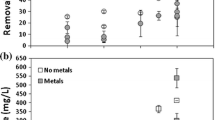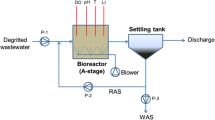Abstract
In this study, for the first time, weak wastewater was remediated using biological treatment with microalgae–sludge cultivation combined with physical absorption by the activated carbon. The influences of each factor on the process efficiency have been studied in detail by statistical analysis. The experimental design was carried out using Taguchi arrangement. Chemical oxygen demand (COD) and biological oxygen demand (BOD) were measured as responses over 16 h of the treatment. It was found that the physical absorption was controlled the treatment with the highest contribution (> 71%). We show that the second and third ranks correspond to the microalgae and activated sludge, respectively. The optimal conditions to minimize COD were obtained at the activated carbon of 0.2 g/l, microalgae of 1 ml/l and activated sludge of 1 ml/l. Our study shows that the reductions in COD and BOD are more than 90% and 93%, respectively. The validity of the predicted mathematical model also has been confirmed by measuring the responses at the optimal conditions, resulting in low deviation. Therefore, the process that we studied in this paper can be utilized efficiently in wastewater treatment plants. Finally, we compare the results obtained from this method with other scenarios published, finding a good agreement.


Similar content being viewed by others
Abbreviations
- as:
-
Activated sludge
- ac:
-
Activated carbon
- ma:
-
Microalgae
- COD:
-
Chemical oxygen demand
- BOD:
-
Biological oxygen demand
- DO:
-
Dissolved oxygen
- TSS:
-
Total suspended solids
- TKN:
-
Total Kjeldahl nitrogen
- ANOVA:
-
Analysis of the variance
- S/N:
-
Signal-to-noise ratio
- C. vulgaris :
-
Chlorella vulgaris
References
Aber S, Salari D, Parsa M (2010) Employing the Taguchi method to obtain the optimum conditions of coagulation–flocculation process in tannery wastewater treatment. Chem Eng J 162(1):127–134
Ahmed MB, Zhou JL, Ngo HH, Guo W, Thomaidis NS, Xu J (2017) Progress in the biological and chemical treatment technologies for emerging contaminant removal from wastewater: a critical review. J Hazard Mater 323:274–298
American Public Health Association A (1995) Standard methods for the examination of water and wastewater. American Public Health Association, Washington
Ávila C, Garfí M, García J (2013) Three-stage hybrid constructed wetland system for wastewater treatment and reuse in warm climate regions. Ecol Eng 61:43–49
Chan YJ, Chong MF, Law CL, Hassell D (2009) A review on anaerobic–aerobic treatment of industrial and municipal wastewater. Chem Eng J 155(1–2):1–18
Cho S, Lee N, Park S, Yu J, Luong TT, Oh Y-K, Lee T (2013) Microalgae cultivation for bioenergy production using wastewaters from a municipal WWTP as nutritional sources. Bioresour Technol 131:515–520
Crini G, Lichtfouse E, Wilson LD, Morin-Crini N (2019) Conventional and non-conventional adsorbents for wastewater treatment. Environ Chem Lett 17(1):195–213
Doucha J, Lívanský K (2012) Production of high-density chlorella culture grown in fermenters. J Appl Phycol 24(1):35–43
Gao F, Li C, Yang ZH, Zeng GM, Mu J, Liu M, Cui W (2016) Removal of nutrients, organic matter, and metal from domestic secondary effluent through microalgae cultivation in a membrane photobioreactor. J Chem Technol Biotechnol 91(10):2713–2719
Hamze H, Akia M, Yazdani F (2015) Optimization of biodiesel production from the waste cooking oil using response surface methodology. Process Saf Environ Prot 94:1–10
Hanjra MA, Qureshi ME (2010) Global water crisis and future food security in an era of climate change. Food Policy 35(5):365–377
Huggins TM, Haeger A, Biffinger JC, Ren ZJ (2016) Granular biochar compared with activated carbon for wastewater treatment and resource recovery. Water Res 94:225–232
Koo CH, Mohammad AW (2011) Recycling of oleochemical wastewater for boiler feed water using reverse osmosis membranes: a case study. Desalination 271(1–3):178–186
Meneses M, Pasqualino JC, Castells F (2010) Environmental assessment of urban wastewater reuse: treatment alternatives and applications. Chemosphere 81(2):266–272
Menon KR, Balan R, Suraishkumar G (2013) Stress induced lipid production in chlorella vulgaris: relationship with specific intracellular reactive species levels. Biotechnol Bioeng 110(6):1627–1636
Mohan SV, Sirisha K, Rao RS, Sarma P (2007) Bioslurry phase remediation of chlorpyrifos contaminated soil: process evaluation and optimization by Taguchi design of experimental (DOE) methodology. Ecotoxicol Environ Saf 68(2):252–262
Mujtaba G, Rizwan M, Kim G, Lee K (2018) Removal of nutrients and cod through co-culturing activated sludge and immobilized chlorella vulgaris. Chem Eng J 343:155–162
Mutamim NSA, Noor ZZ, Hassan MAA, Yuniarto A, Olsson G (2013) Membrane bioreactor: applications and limitations in treating high strength industrial wastewater. Chem Eng J 225:109–119
Otondo A, Kokabian B, Stuart-Dahl S, Gude VG (2018) Energetic evaluation of wastewater treatment using microalgae, chlorella vulgaris. J Environ Chem Eng 6(2):3213–3222
Ozyonar F (2016) Optimization of operational parameters of electrocoagulation process for real textile wastewater treatment using Taguchi experimental design method. Desalin Water Treat 57(6):2389–2399
Park SK, Do Kim K, Kim HT (2002) Preparation of silica nanoparticles: determination of the optimal synthesis conditions for small and uniform particles. Colloids Surf A 197(1–3):7–17
Prieto D, Swinnen N, Blanco L, Hermosilla D, Cauwenberg P, Blanco Á, Negro C (2016) Drivers and economic aspects for the implementation of advanced wastewater treatment and water reuse in a PVC plant. Water Resour Ind 14:26–30
Renuka N, Sood A, Prasanna R, Ahluwalia A (2015) Phycoremediation of wastewaters: a synergistic approach using microalgae for bioremediation and biomass generation. Int J Environ Sci Technol 12(4):1443–1460
Roudsari FP, Mehrnia MR, Asadi A, Moayedi Z, Ranjbar R (2014) Effect of microalgae/activated sludge ratio on cooperative treatment of anaerobic effluent of municipal wastewater. Appl Biochem Biotechnol 172(1):131–140
Sadeddin K, Naser A, Firas A (2011) Removal of turbidity and suspended solids by electro-coagulation to improve feed water quality of reverse osmosis plant. Desalination 268(1–3):204–207
Su Y, Mennerich A, Urban B (2012) Synergistic cooperation between wastewater-born algae and activated sludge for wastewater treatment: influence of algae and sludge inoculation ratios. Bioresour Technol 105:67–73
Wang L, Min M, Li Y, Chen P, Chen Y, Liu Y, Wang Y, Ruan R (2010) Cultivation of green algae chlorella sp. in different wastewaters from municipal wastewater treatment plant. Appl Biochem Biotechnol 162(4):1174–1186
Wang D, Tong F, Aerts P (2011) Application of the combined ultrafiltration and reverse osmosis for refinery wastewater reuse in Sinopec Yanshan Plant. Desalin Water Treat 25(1–3):133–142
Wang L, Liu J, Zhao Q, Wei W, Sun Y (2016) Comparative study of wastewater treatment and nutrient recycle via activated sludge, microalgae and combination systems. Bioresour Technol 211:1–5
Wong S, Ngadi N, Inuwa IM, Hassan O (2018) Recent advances in applications of activated carbon from biowaste for wastewater treatment: a short review. J Clean Prod 175:361–375
Zhao S, Huang G, Cheng G, Wang Y, Fu H (2014) Hardness, cod and turbidity removals from produced water by electrocoagulation pretreatment prior to reverse osmosis membranes. Desalination 344:454–462
Acknowledgements
This research did not receive any specific grant from funding agencies in the public, commercial or not-for-profit sectors.
Author information
Authors and Affiliations
Corresponding author
Additional information
Editorial responsibility: J. Chen.
Rights and permissions
About this article
Cite this article
Zahmatkesh, S., Pirouzi, A. Effects of the microalgae, sludge and activated carbon on the wastewater treatment with low organics (weak wastewater). Int. J. Environ. Sci. Technol. 17, 2681–2688 (2020). https://doi.org/10.1007/s13762-020-02661-9
Received:
Revised:
Accepted:
Published:
Issue Date:
DOI: https://doi.org/10.1007/s13762-020-02661-9




